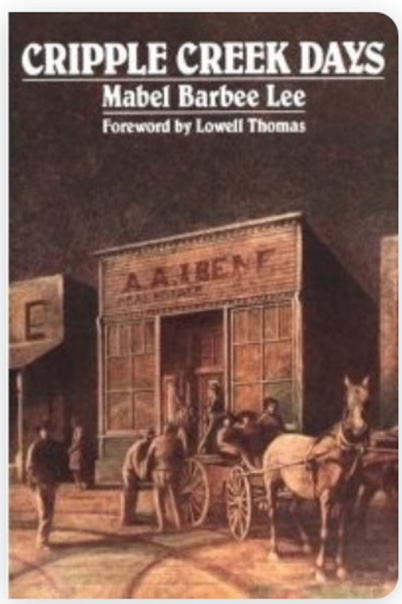April 25, 1896, was a clear and bright day in Cripple Creek. It was a lively and prosperous (although dirty and unkempt) city populated by prospectors, miners, scammers, prostitutes, dreamers and others with less romantic pursuits. There were grocers, dressmakers, railroaders, firefighters, stablemen, brewers, bartenders, musicians and assorted tradesmen of all kinds.
The city had a thriving daily newspaper, the Cripple Creek Morning Times. On the front page: an interview with Mayor George Pierce, who proudly noted that “Our splendid system of waterworks makes it possible to control and extinguish the most serious conflagrations; henceforth, our citizens can be free of this terror.”
Mabel Barbee, a precocious 12-year-old whose father was a respected but barely successful prospector, was raking up the backyard of their cottage when she heard a gunshot, followed by five more. That was the fire signal, not a shootout.

Sixty-two years later, she remembered it vividly. As described in the first volume of her autobiography “Cripple Creek Days,” the fire was unstoppable.
“Billows of heavy smoke streaked with thin, purplish streamers began to roil from the tenderloin toward Bennett Avenue,” she wrote. The horse-drawn fire engine rushed to the fire, but “the fire hose had no more effect than a lawn sprinkler.”
Half the town burned, causing more than a million dollars (today, about $36 million) in damage, but much of the business district survived — until the fire returned four days later. Despite snow and fog, “A flash of crimson lit the sky above the Portland Hotel, at the corner of Second and Myers, and all that had been left of Bennett Avenue became a spiraling mass of smoke and flames.”
The city had literally disappeared, and thousands were homeless and without shelter. Yet help was on the way.
By 3 p.m. that day, as Marshall Sprague recounted in “Money Mountain,” Cripple Creek mining titan Jimmie Burns was on the telephone with the Colorado Springs mayor J.C. Plumb, and four leading citizens of Colorado Springs and Colorado City: W.S. Stratton, Spencer Penrose, Verner Z. Reed and Irving Howbert.
They didn’t waste any time. By 5 p.m. the next day, two special trains with relief supplies of food, clothing, blankets and tents were on their way to the Creek, followed by a third train at 2 a.m.
In a few days, every resident was sheltered, solvent and ready to help rebuild. Rich or poor, they were optimistic and entrepreneurial. Mabel’s father built a new and much better cottage on their lot, as did their neighbors.
A new city arose on Bennett Avenue from the ashes, one made of fine brick and stone that reflected the promise and prosperity of a city built on gold. No longer a disreputable collection of shanties and shacks, the new Cripple Creek was celebrated throughout the country.
The city’s transformation was capped by the opening of the opulent and luxurious National Hotel, which featured such amenities as an elevator, private bathrooms, walls paneled in golden oak and a banquet hall that could accommodate 200 people.
Everybody in the mining district had been invited to come to the housewarming, so Mabel and her mother, Kitty, dressed up and went to the party.
They were optimistic and entrepreneurial.
On opening night, Cripple Creek’s glitterati turned out for the opening. After the banquet, many guests stayed to waltz to the music of the Cripple Creek Band.
Suddenly, they heard “startling sounds of scuffling and gasps of profanity coming from the adjoining barroom. A man and a woman had ridden into the saloon, horseback, and everyone shouted with laughter when they ordered a couple of horse’s necks cocktails.
The couple? Spencer Penrose and Grace Carlisle, a ravishing beauty from Pearl deVere’s Old Homestead, a legendary brothel that catered to a hyper-wealthy clientele.

The drink? 1 1/2 ounces brandy, 4 ounces ginger ale and 3 dashes of angostura bitters.
On that bright golden evening, everything seemed blessed in Mabel’s world. But, as she and her mother lingered shyly in the hotel, she wondered about the future.
Did her mother despair of her “freckle-nosed, long-legged girl”? Would she ever be a beauty in blue chiffon, like Ethel Frizzell (who would soon marry Cripple Creek millionaire Bert Carlton)? Would her father ever strike it rich?
She needn’t have worried — hers was to be a brilliant and extraordinary life, although marred by early tragedy. In her first year at Colorado College, her parents died of pneumonia within a few weeks of each other.
She thought she’d have to drop out of college and go to work, but the Cripple Creek mining community came together and paid for “Jonce’s girl” to stay in college. She graduated with honors, taught school in Victor, was offered a job at Colorado College, helped found Bennington College, wrote beautifully and lived into her 90s.
Did she become a great beauty? Charles Emery photographed her at 18. One word: Wow!!!

